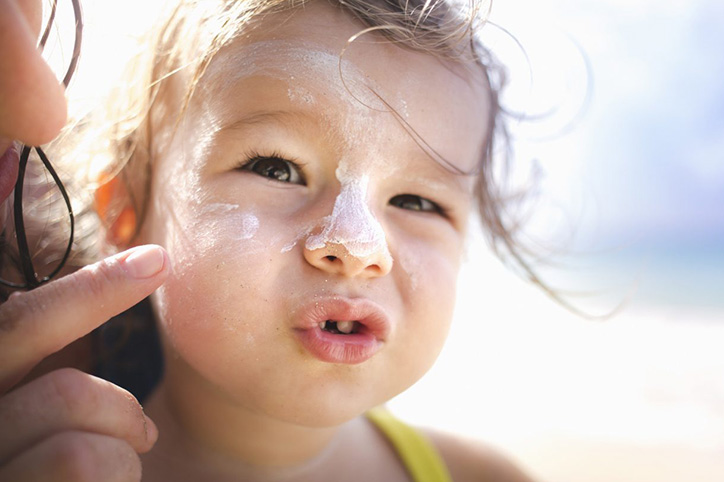One of the best things you can do to keep your baby’s skin baby soft… apply sunscreen! Many parents don’t realize that while the burning UVB rays may only be strong when the sun is shining, UVA (the aging and cancer-causing rays) are strong year-round. It’s therefore important to start good habits of daily sunscreen application early, and certainly as soon as your baby is getting significant sun exposure. “SPF is a good idea anytime babies are in the sun, including in the winter,” says Kim Walls, founder of BEB Organic. “Often people associate the need for sunscreen with heat, but the sun can burn the skin even on a cold day. A single bad sunburn increases the risk of skin cancer for the rest of a baby’s life.”
“If babies are going to the beach, pool or outside it’s critical to minimize sun damage,” says Dr. Kenneth Mark, cosmetic dermatology expert. “One German study followed kids who diligently were kept out of the sun. Those kids grew up to have significantly less moles and significantly lowered their risk of melanoma, the most deadly form of skin cancer.”

That said, many experts suggest not applying sunscreen until baby is six months old. “That recommendation is likely because many of the chemicals in typical sunscreens get into the bloodstream and can cause problems with the endocrine and nervous systems,” says Walls. “Mineral sunscreens – those made with zinc and titanium – sit on the surface of the skin to reflect light, so in many ways are like shade. Most pediatricians advise that if a baby is in the sun and can’t be properly shaded, use sunscreen.”
It’s no surprise then that whether to opt for chemical or physical sun protection has become a hotly debated topic. The latest research shows that six common chemical sunscreen ingredients absorb into the bloodstream and greatly exceed levels considered safe. “In a recent study one ingredient, oxybenzone, showed an absorption rate 188 times the safe level after one application,” says dermatologist Dr. Dennis Gross, founder of the eponymous skincare line. “After four applications, absorption increased 500 times the safe level. All chemicals stayed elevated in the blood anywhere from one to 21 days, depending on the chemical sunscreen ingredient.”
The study also reported that these ingredients can make their way into women’s breast milk and cause endocrine hormonal disturbances. “Oxybenzone in particular has been shown to have effects on the endocrine system, including altering of birth weights and shortening of pregnancies,” says Dr. Mark. “In addition, researchers found that adolescent boys with higher oxybenzone measurements had significantly lower total testosterone levels, however, this was not a prolonged case-controlled study as it was only based on short term observation.”

Chemical sunscreens lack safety data regarding whether or not they are carcinogens and harm developing children and, because of this, many leading dermatologists, including Dr. Gross and Dr. Mark, are strongly urging patients to discontinue the use of chemical sunscreens and look for physical block alternatives for both themselves and their children. Look for ‘zinc oxide’ or ‘titanium dioxide’ on the ingredient list.
Walls takes it one step further and suggests parents also avoid petroleum, parabens and fragrance. “If a brand isn’t formulating with those three ingredients, there’s a high likelihood they aren’t using any other (or at least many other) undesirable ingredients. The reason to avoid harsh chemicals in skincare, including SPF, is because those chemicals end up in our blood, our oceans, our food supply and in our air. Reproductive potential of humans is plummeting. Micro-plastic contamination in our air, water, and food is skyrocketing. The use of harsh chemicals in our personal care products is part of why those things are happening.”
How do you feel about sunscreen for kids?








